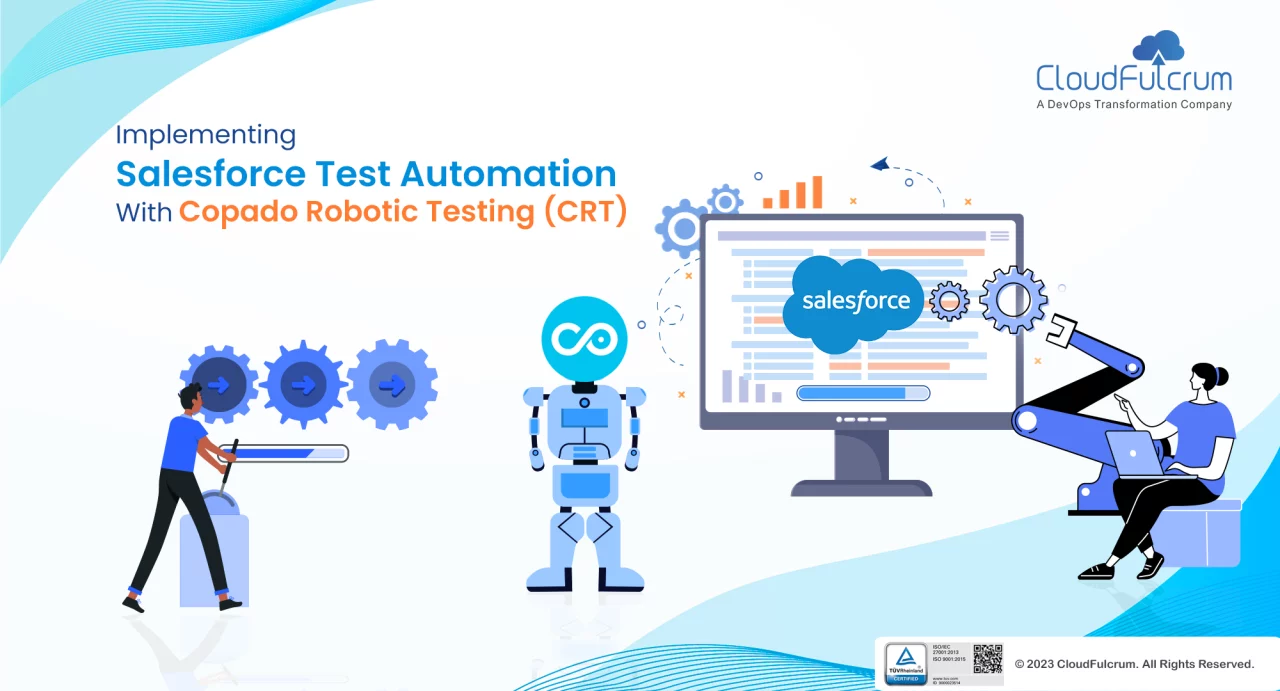Introduction
In the fast-paced delivery of projects, meeting estimated timelines within the deadline is essential. One way to achieve this is by utilizing automated tools like Selenium. However, if the code needs to be changed repeatedly, relying on Selenium can pose challenges. However, manual testing, despite its necessity, can consume 30-50% of testing time, potentially leading to costly errors. This is where Copado Robotic Testing (CRT) comes into play. In this blog post, we will explore the significant role CRT can play in your organization, highlight the numerous benefits it offers, and explain why choosing this transformative approach is worthwhile.
CRT: HOW DOES IT WORK?
To understand the CRT, we will use our own app CloudFulcrum extensions for Copado. CloudFulcrum Extensions for Copado (CFX) is a comprehensive managed package designed to enhance the governance and management of your Copado platform. This package provides a set of governance utilities, an audit report of Copado feature utilization, and improves the DevOps maturity of your Salesforce practice
The Copado Cleanup Utility is a tool utilized to maintain a clean and organized Copado infrastructure. Its primary purpose is to facilitate the cleaning of various aspects within Copado, such as records and branches, to ensure optimal system performance and organization. By leveraging the utility, users can effectively remove unnecessary user stories, improving the overall cleanliness and efficiency of their Copado environment. The Copado Cleanup Utility consists of three main segments: record cleanup, git branches, and archival records. These segments provide specific functionalities for maintaining cleanliness and organization within the Copado platform.
In this video tutorial, we will demonstrate how the Copado Release Testing (CRT) works by testing on our “CloudFulcrum Extensions for Copado”. The tutorial will cover the testing of the core features of the managed package which include:
- Copado Cleanup Utility
- Feature audit
- DevOps maturity report.
By the end of the video tutorial, you will have a comprehensive understanding of how automation is done within a sprint. You will also see how easy it is to run test cases without manual effort. In fact, automation has reduced manual effort and increased performance by 70%.
How does Copado Robotic Testing (CRT) differ from other tools?
When it comes to choosing Copado Robotic Testing (CRT) over other tools for your regression testing needs, there are several reasons why it can be a beneficial option:
1.Time Efficiency: Copado Robotic Testing offers a faster and more efficient way to perform regression testing. In your case, you need to run 1000 regression tests within a two-week sprint. Copado Robotic Testing can complete the testing process in just 2 to 3 days, allowing you to identify errors and make necessary changes promptly.
2.Flexibility: Copado Robotic Testing offers two options: coding and robotic testing. With the coding option, users can write and execute automated test scripts using programming languages, allowing for customization and precise control over the testing process. On the other hand, robotic testing utilizes software robots to simulate human interactions with the application or system being tested, making it more user-friendly and accessible to those without extensive coding knowledge. This adaptability ensures that you have alternative methods to tackle any challenges that may arise during the testing process.
3.Comprehensive Test Coverage: With Copado Robotic Testing, you can achieve comprehensive test coverage, ensuring that all critical functionalities and scenarios are tested thoroughly. This comprehensive approach reduces the risk of missing any potential issues, giving you more confidence in the quality of your software.
4.Automation Capabilities: Copado Robotic Testing offers powerful automation capabilities, enabling you to automate repetitive testing tasks. This automation saves time and effort, allowing your team to focus on other critical aspects of the software development lifecycle.
5.Error Detection and Mitigation: By using Copado Robotic Testing, you can quickly identify errors and issues at the end of each week. This early detection helps you mitigate the changes promptly, reducing the likelihood of major setbacks and ensuring a smoother development process.
Conclusion
CloudFulcrum offers a compelling solution for organizations seeking to implement Copado Robotic Testing (CRT). Its scalable infrastructure, cost-effectiveness, and flexibility make it an ideal choice for efficient and comprehensive testing across different configurations. The automation capabilities streamline testing processes, while collaboration features and detailed reporting enhance team collaboration and decision-making. If you would like to know how CloudFulcrum can help your organization, contact us or email us at support@staging.cloudfulcrum.com.

